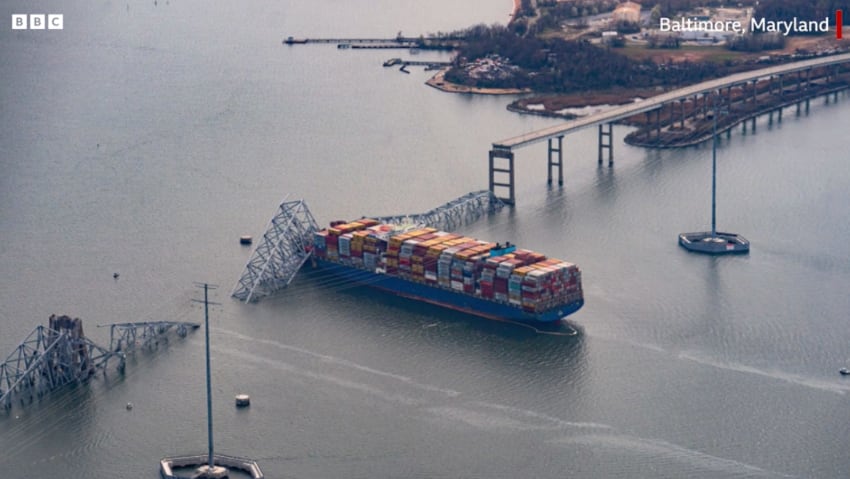Baltimore Bridge collapse highlights complexities of marine liability claims & importance of adaptability: Howden
- November 7, 2025
- Posted by: Kassandra Jimenez-Sanchez
- Category: Insurance

As the marine re/insurance sector marks the one-year anniversary of the Baltimore Bridge collapse, the industry continues to navigate the long-term implications of what has been one of its most significant loss events for the industry in recent years, global re/insurance broker Howden highlights.
While initial estimates placed the potential cost as high as $2-3 billion, a market consensus around $1.5 billion emerged by the fourth quarter of 2024, shaping expectations for the January 1, 2025, renewals.
As the collapse happened just ahead of the 1.4.2024 renewals, its impact was not immediately reflected in pricing. Due to the closeness to renewal dates and initial uncertainty about the loss, the event was not factored into the renewal cycle, Howden analysts note.
Despite the scale of the disaster, the overall impact on market pricing was moderate, Howden noted.
The 1.1.2025 renewals saw a gradual risk adjusted softening between flat to -10%; whereas without the Baltimore event, pricing may have declined further.
Richard Miller, Managing Director, Specialty Reinsurance at Howden Re said: “While the loss acted as a stabilising force in an otherwise softening market, it did not trigger the widespread hardening that some anticipated.
“A combination of new entrants into the marine space, competitive pressures, and strong prior-year profitability allowed the market to absorb the loss without a significant correction. Rates at 1.4.25 followed a similar trajectory to what we observed at 1.1.2025, with a continuation of a downward trend.”
While the broader market absorbed the impact gradually, the secondary market, where Howden Re plays a significant role, experienced a more immediate reaction.
The International Group of P&I Clubs placement saw notable rate increases across all layers. Similarly, facultative placements, which often mirror original pricing, in some instances rose considerably higher than initial rate movements, regardless of their structure.
Miller noted: “This is where we saw the most immediate impact. Despite rate hikes, these deals continued to be placed, reflecting sustained demand for spreading exposure. This underscores the resilience of the secondary market in adjusting pricing to reflect emerging risk realities.”
The limited pricing reaction to the Baltimore Bridge collapse raises the question, if an event of this scale did not drive a hard market, what would?, Howden highlighted.
Miller stated: “A few years ago, a loss of this magnitude would have hardened the market. The difference today is the level of competition – there are simply more players competing for a finite book of business, diluting the impact of individual loss events.”
Howden analysts keep questioning if multiple significant losses or a single larger-scale event could force a hardening?, to which Miller commented: “There is more capacity than ever looking to expand, and the industry’s ability to absorb these losses – while keeping rates relatively stable – remains a key factor in mitigating widespread market correction.”
Historically, large-scale pollution events and catastrophic loss of life have been key drivers of market hardening. While the Baltimore Bridge collapse represents a major insured loss, the absence of these two factors limited its ability to instigate a broader market correction, Howden explains.
Analysts suggest that a major environmental disaster, particularly in US waters, or a large-scale casualty event could have a far more significant impact on market trajectory.
Looking ahead, the Baltimore Bridge collapse is undoubtedly a “long-tail loss,” with the final settlement process expected to take years. Marine liability claims are known for their extended resolution periods, with the ongoing 2019 Golden Ray claim as an example.
The complexity of such events, encompassing legal fees, multiple claimants, investigations, and regulatory factors, contributes to these protracted timelines.
However, this loss differs from past events, Howden notes. Unlike the Costa Concordia in 2012, where logistical and legal delays drove costs significantly higher, the US Army Corps of Engineers completed the Baltimore bridge wreck removal within weeks, avoiding prolonged complications.
“While claims from surrounding businesses remain a factor, the originally estimated $360 million loss of revenue during the rebuild period was significantly offset by increased toll revenues from neighbouring bridges and is now more likely to be in the region $50m – $100 million,” Miller explains. “This loss, while significant, is relatively clean in terms of known liabilities.”
Additionally, according to the report, there is potential for the State of Maryland to bear some responsibility for a portion of the rebuild costs, given prior recommendations to update the bridge’s structure were not implemented, could influence discussions regarding liability.
Howden concludes: “Ultimately, the Baltimore Bridge collapse acted as a speed-bump on softening rates, but did not reverse the broader trend. The collapse, while substantial, highlights the complexities of marine liability claims and reinforces the importance of adaptability in a market increasingly shaped by emerging risks and the strategic role of the secondary market.”
This website states: The content on this site is sourced from the internet. If there is any infringement, please contact us and we will handle it promptly.



